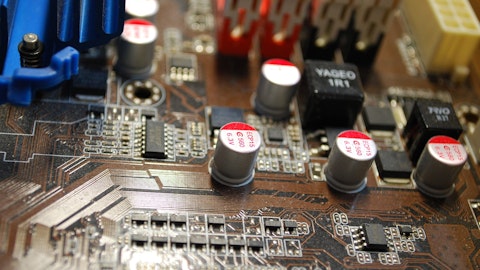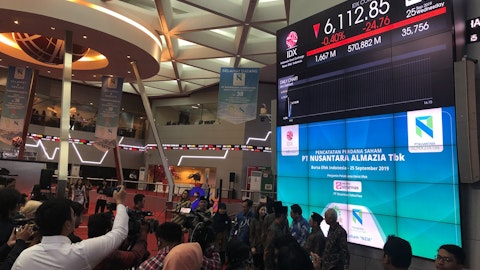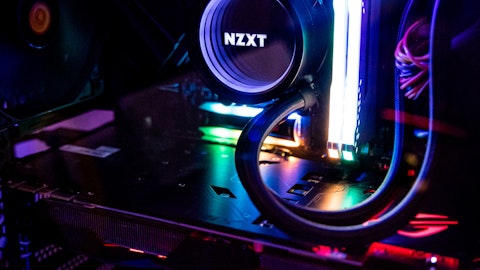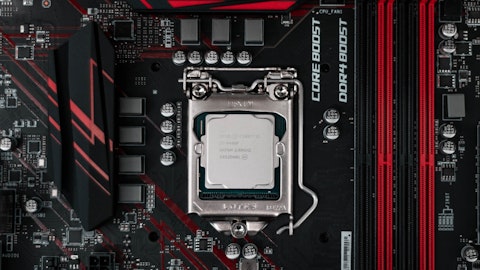United Microelectronics Corporation (NYSE:UMC) Q4 2022 Earnings Call Transcript January 16, 2023
Operator: Welcome everyone to UMC’s 2022 Fourth Quarter Earnings Conference Call. All lines have been placed on mute to prevent background noise. After the presentation, there will be a question-and-answer session. Please follow the instructions given at that time if you would like to ask a question. For your information, this conference call is now being broadcast live over the Internet. Webcast replay will be available within an hour after the conference is finished. Please visit our website www.umc.com under the Investor Relations, Investors Events section. I would like to introduce Mr. Michael Lin, Head of Investor Relations at UMC. Mr. Lin, you may begin.

jonas-svidras-e28-krnIVmo-unsplash
Michael Lin: Thank you, and welcome to UMC’s conference call for the fourth quarter of 2022. I’m joined by Mr. Jason Wang, President of UMC; and Mr. Chi-Tung Liu, the CFO of UMC. In a moment, we will hear our CFO present the fourth quarter financial results, followed by our President’s key message to address UMC’s focus and first quarter 2023 guidance. Once our President and CFO complete their remarks, there will be a Q&A section. UMC’s quarterly financial reports are available at our website www.umc.com under the Investors Financials section. During this conference, we may make forward-looking statements based on management’s current expectations and beliefs. These forward-looking statements are subject to a number of risks and uncertainties that could cause actual results to differ materially, including the risks that may be beyond the company’s control.
For a more detailed discussion of these risks and uncertainties, please refer to our recent and subsequent filings with the SEC and the ROC security authorities. During this conference you may view our financial presentation material, which is being broadcast live through the Internet. Now I would like to introduce UMC’s CFO, Mr. Chi-Tung Liu, to discuss UMC’s fourth quarter 2022 financial results.
Chi-Tung Liu : Thank you, and happy new year to everyone. Thank you for joining our call. I would like to go through the 4Q €˜22 investor conference presentation material, which can be downloaded or viewed in real time from our website. Starting on Page four, the fourth quarter of 2022, consolidated revenue was TWD67.84 billion with gross margin rate at 42.9%. Net income attributable to the stockholder of the parent was TWD19 billion and earnings per ordinary shares were TWD1.54. Utilization rate came down to 90% in 4Q from 100% in the previous quarter. And on Page five, this is quarterly result. Revenue declined by 10% sequentially to TWD67.8 billion. Gross margin rate was 42.9% or TWD29.1 billion. We kept the operating expenses at nearly the same level quarter-over-quarter, which is around TWD6.79 billion.
And total operating income declined by roughly 20% to TWD23.6 billion. And net income attributable to the shareholder of the parent is TWD19 billion or TWD1.54 EPS in the 4Q of €˜22. Our next page is the full year result of 2022. Total revenue grew by 31% to TWD278.7 billion and operating income has more than doubled to TWD104 billion and the growth rate was 101% year-over-year. And EPS grew to TWD7.09 in 2022 compared to TWD4.57 in the previous year. On Page seven, our cash on hand currently stands at TWD173.8 billion, with our total equity now is over $10 billion mark to TWD335.4 billion. ASP on Page eight, in Q4 continued to edge up slightly in the fourth quarter of 2022. On Page nine, for revenue breakdown, the change was most significant in the North American market, which represent about 30% of our total revenue compared to 23% in the previous quarter.
Asian probably showed a biggest decline from 52% of revenue to 54%. On Page 10, that’s the full year breakdown and the change is less significant compared to the quarterly results. Asia represents 51% of the total pie and U.S. represent about 24% in the full year of 2022. On Page 11, quarterly breakdown of IDM versus Fabless stand at 19% IDM and 81% Fabless. For full year, on the next page, it remain almost unchanged with IDM represented about 15% for the full year revenue. On Page 13, communication, computer and consumer didn’t change much on quarterly sequential comparison with communication still remains the biggest of 45% of the total revenue. Other segment, which include auto has continued to grow at a faster pace compared to the rest of the segment and is now 18% of our total revenue.
For the full year, communication remained around 45%, and consumer is about 26%. On Page 15, the quarterly technology breakdown. Now we can see 22/28 nanometer represent 28% of the biggest pie of the chart for the Q4 revenue. 40 nanometer is about 17%. The legacy 8-inch of 0.25 and above are declined the most in the 4Q 2022. For the full year, 20/28 nanometer represented about 24% also the biggest pie of the chart for the full year of 2022. On Page 17, the quarterly capacity breakdown. We have some new maintenance in Taiwan and also China for Q1 2023. So there’s some minor decline in available capacity, which will gradually back to normal in Q2 of 2023. And there will be also some new capacity come on stream in the third quarter or our P5 and P6 in Taiwan.
Our next page is our current full year cash based budget or CapEx, right now is about $3 billion with 90% of the $3 billion contribute to around all the 12-inch related expansion. So the above is a summary of UMC’s result for Q4 2022. More details are available in the report, which has been posted on our website. I will now turn the call over to President of UMC, Mr. Jason Wang.
See also 23 Most Powerful Countries in the World and US States’ GDP Compared to Other Countries.
Jason Wang: Thank you, Chi-Tung. Good evening, everyone. Here, I would like to share UMC’s fourth quarter and 2022 highlights. In the fourth quarter, due to a significant slowdown across most of our end markets and inventory correction in the semiconductor industry, our wafer shipments fell 14.8% quarter-over-quarter, while overall fab utilization rate dropped to 90%. Average selling price increased slightly during the quarter as a result of our ongoing product mix optimization efforts, moderating the decline in revenue. For the full year 2022, UMC’s revenue hit the record high of TWD279 billion, while operating income exceed TWD100 billion. Gross margin reached 45%, driven by a more favorable foreign exchange rate, expanding 22/28 nanometer portfolio and nearly added capacity.
We have taken advantage of the industry upturn over the past two years to enhance our differentiation in specialty technology offering, improved profitability and different relationship with our key customer. Revenue from 22/28 nanometer technology increased more than 56% year over year, driven by our industry leading 28 nanometer process for OLED display drivers and image signal processors. Our automotive segment also delivered impressive growth in 2022, increasing 82% year-over-year to account for approximately 9% of total sales. We expect this segment will continue to be a key growth catalyst in 2023 and beyond, driven by the long-term trend of vehicle electrification and automation. UMC is well positioned to serve the market with our comprehensive portfolio of auto-grade process technologies and facilities certified according to the rigorous quality standards, while we continue to build strong partnerships with world-class automotive leaders.
Given the soft global economic outlook for 2023, we expect the current challenging environment to persist through the first quarter as customers’ days of inventory are still higher than normal while order visibility remains low. To manage this period of weakness, the company is implementing strict cost control measures and deferring certain capital expenditures where possible. In the longer term, we remain positive that UMC’s differentiated specialty technology leadership, geographically diversified capacity offering, and quality and operational excellence will enable the company to capture demand, fueled by continuous digital transformation across industries and be the foundry of choice for leading customers. Now let’s move on to the first quarter 2023 guidance.
Our wafer shipment will decline by high teens percentage range. ASP in U.S. will remain flat. Please note that we expect a 3% to 4% adverse impact on foreign exchange on revenue. Gross profit margins will be in the mid 30% range. Capacity utilization rate will be approximately 70%. Our 2023 cash based CapEx will be budgeted at $3 billion. That concludes my comments. Thank you all for your attention. Now we are ready for questions.
Q&A Session
Follow United Microelectronics Corp (NYSE:UMC)
Follow United Microelectronics Corp (NYSE:UMC)
Operator: Thank you. Ladies and gentlemen, we will now poll for questions. Thank you. And our first question comes from Randy Abrams with Credit Suisse. Please go ahead, Randy. Thank you.
Randy Abrams: Okay. Yes. Thank you. Good evening. My first question, if you could just discuss your view on the scope of this business cycle. With the high teens decline in first quarter, do you expect it to mark the low? Where do you see or expect given demand in the inventory, further correction into second quarter? And then if you could give a view just on the end market. Do you see any areas getting closer to stabilization or inventory levels already getting down then from the stronger like auto/other, are you seeing any weakness start to come in?
Jason Wang: Well, currently, we are still in the midst of the inventory correction. Like I mentioned earlier, however, we did see some inventory improvement in some segments, such as TDDI for high voltage devices in mobile space. And so, we are working closely with our strategic customer to proactively address those inventory burden in addition to the TDDI and we expect those inventory situation will improve gradually and with high visibility in second half 2023. And so we think that the inventory situation is improving. But probably not going to have — not going to become better until second half of 2023. For the 2023 outlook. Well, I mean, given the cyclical nature of the semi industry, there is no one that’s immune from the end market downturns.
While we were able to mitigate our loading in the second half of our 2022 amidst the downturn, thanks to the growth in our auto business sustain our business momentum and which I also touched and search about 82% year-over-year. But for the first half of 2023, we do foresee a continued softened demand in smartphone PC consumer market that will continue for the inventory digestion reason. Meanwhile, the inventory digestion will continue to be our first priority. Nevertheless, we expect the first half, if not, the Q1 will be the trough.
Randy Abrams: Okay. Yes. So it sounds like first half, if not, Q1. So it’s still too early to call for sure, not pretty close. It sounds like based on what you see, if that’s correct. And then, I wanted to ask, your breakeven utilization is much lower now, like at 70% you have a mid-30s gross margin still. So is that influencing or if you could discuss your feel on pricing, given some cycles you might be close to loss making. But how is your view on your baseline pricing and also just pressure coming from customers needing help out? If you could discuss a view how well it could continue to hold? And if you could discuss the latest on how the LTAs on the 28 new capacity are holding up?
Jason Wang: First, given the continued end demand weakness in the PC smartphone and consumer segment, we are experiencing the prolonged inventory correction cycle. And we believe the pricing adjustment at this point will still produce very limited effect in demand creation under the circumstance. And for the UMC’s pricing consideration is still based on limit upon the value proposition and supply chain relevance. We expect ASP outlook to remain firm in 2023. While the ASP is not the only consideration in customer management, the yield improvement, technology offering, capacity support, also key factors to strengthen our customers’ competitiveness, which will continue supporting that. Meanwhile, we will continue working with our customers to make sure they remain competitive and relevant in their respective market.
So for the outlook of the ASP today, we still remain firm in 2023. Now for the 28 nanometer ASP situation, we continue with our cost reduction and productivity improvement efforts to remain competitive even in light of the higher inflationary costs throughout the entire supply chain. And we will cooperate with our customers to navigate through those headwinds in conjunction with our internal cost reduction effort. But we still feel we have pretty solid position on 28. And if there is any cost related, we will closely working with our customers on that. And I think there’s also a question about LTA?





